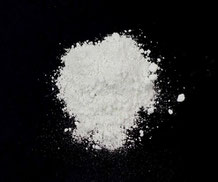- Deutsch
- English
Formulas:

Lithopone primer:
Lithopone is an artificial, non-toxic white pigment consisting of barium sulphate (barite, BaSO4) and zinc sulphide (ZnS). It is produced in a special manufacturing process in which both components are precipitated in a single operation.
Depending on the zinc sulphide content, different types of lithopones are distinguished.
Lithopone (Klick on picture)
As the zinc sulphide content increases, so does its brightness. Lithopone is also known as Charlton white, Chinese permanent white, enamel white, sulphur zinc white or sulphide white.
Lithopone was discovered in the first half of the 18th century. It is still used today for primers, paints and fillers. It can also be found as a pigment in pastels, oil paints and plastic dispersions. It is a well light-resistant pigment, compatible with all pigments and binders and also non-toxic.
Lithopone + binder (glue water) gives a very good primer.
1. We take gelatine powder or leaf gelatine (edible
gelatine) and mix it with a thin liquid aqueous solution.
Wallpaperpaste (methyl cellulose) can also be used to produce glue water.
2. Now stir the lithopone powder into the glue water.
3. Spread this white primer on the tensioned paper with a sponge, paint roller or flat brush. If we use a brush crosswise, if we use the
sponge in circular movements. Please apply several thin coats rather than once too thickly! In the past, glue water was usually
produced from rabbit glue (skin glue). Skin glue is a glutinous glue. The starting material glutin is found on animal skins. In its
purified form it is used today as edible gelatine.
Other sources also report the use of gum water (gum arabic in aqueous solution) as a binder for primer pigments. Gum arabic is also available in powder form, which can be dissolved in warm water.
Tinted paper (Carta Tinta):
The white primer can also be tinted with paint powder. This can then be used to produce a true Carta Tinta, a drawing paper tinted in colour (often grey), by coating the paper with the coloured primer. This Carta Tinta was very popular with Renaissance
artists.
The coloured tone paper available on the market is unfortunately useless for silverpoints.
Instructions for the use of rabbit skin glue:
If you want to use the old masters' rabbit skin glue for the production of the glue water, here is a manual:
1. Fill a glass half full with the rabbit skin glue. Then pour water into the glass until the height of the upper edge of the granulate.
Allow to soak overnight.
2. Heat a pot of water on the hob and put the softened glue in it and . stir with a wooden stick. After only a few minutes you will have a ready-to-use glue, which can be further diluted with water as desired. The glue should not cook. If it cooks, it can become unusable
3. Do a few experiments and you will soon have the glue consistency you need for your work.
If we need additional rabbit skin glue in the following days, we refill our glue glass with glue granulate, add water and let the whole thing soak again overnight. So we can repeat the process
over and over again. In between, close the glue glass with a lid.
Lithopone priming is the first choice for silverpoint drawings today.
Further primers:
Opaque white:
Cheap opaque white from the tube is diluted in water and applied thinly crosswise with a sponge. Opaque white often contains lithopone in varying proportions.
Zinc white gouache:
Zinc white from the tube (also zinc white acrylic or watercolour paint), contains zinc sulphite. The whole thing is diluted in water as with opaque white.
Gypsum primer: gypsum + binder (glue water)
Fine gypsum (= calcium sulphate) from the hardware store, mixed with glue water as a binding agent.
